home | metro santa cruz index | features | santa cruz | feature story
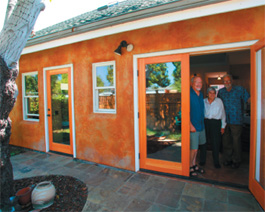
Photograph by Carlie Statsky
Straw House of Happiness: David and his parents, Ellie and Herb Foster, are getting cozy, living in two houses on the same property.
Straw Into Gold
Could a straw-bale granny unit point the way out of Santa Cruz's housing crisis?
By Laura Mattingly
Grandma can't seem to get up the stairs in her house anymore? Ship her to a nursing home. Little Billy's all grown up now but he can't afford to live in Santa Cruz on his 7-Eleven wages?
Buy him a train ticket to Kentucky where the living expenses are cheaper.
You're selling your home to finance your retirement and you've lived here most of your life. ... Where will you go now?
Well, perhaps there's a little room for you in the garage. Or in the backyard. (No, not in a tent, although that could be interesting for a while.)
We're talking about building a granny unit. Or, to use the technical term nowadays, an Accessory Dwelling Unit (ADU). An ADU is nothing scary. Just a tiny house out back. Or a converted garage.
In 2002, the City Council decided to get serious about the housing crisis in Santa Cruz and passed an ordinance encouraging home owners to build ADUs on their properties, which they saw as a practical, fashionable and environmentally conscious solution to sky-rocketing housing prices in a city with no more room to outwardly expand.
Mark Primack, an architect and a City Council member from 2000 through 2004, was a leading proponent of ADU policy changes.
"I came to Santa Cruz young, broke and idealistic," says Primack. "That was in the mid-'70s. Santa Cruz welcomed me when I came here. A young person like myself could find a way to survive here, and get settled here and make a contribution here. And what I deal with as an architect and as a member of the community is, how do I keep that option open to young people, young families in Santa Cruz?"
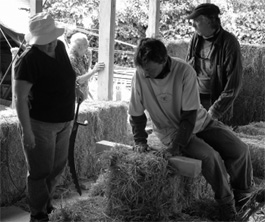
One Bale at a Time: General contracting company Boa Constructor puts together the granny unit's eco-friendly walls by stacking straw bales.
Primack sees secondary housing as a way for many to be able to make Santa Cruz their home, and he maintains that this accessibility is crucial in preserving the character the city is known for.
"The way Santa Cruz as a city dealt with the housing situation was to convert garages to living units. And that's where all our surfers lived, that's where all our artists lived, that's where all our musicians lived in Santa Cruz when I first came here. So it was housing for diversity. That's how we maintained diversity here.
"Of course," Primack adds, "it was all illegal."
So Primack, along with other City Council members and interested people from the community, began a drawn-out effort to change city policy. In the process, Primack hoped to encourage Santa Cruz residents to build safely and legally.
The two new city ordinances were accompanied by a state bill, A.B. 1866, which passed in 2003. The bill encouraged communities statewide to advocate the building of ADUs as a reasonable housing option.
"If you build an ADU," says Primack, "you can accommodate your kids when they're young adults, you can accommodate your aging parents, and when you're empty nesters and retired, you could move into your own ADU."
The City of Santa Cruz ADU Program, developed in 2003, is nationally renowned and has received a number of awards for being on the cutting edge of ADU development. It provides prospective ADU builders with information and assistance, making available free design plans and also offering eligible home owners low-interest loans to assist with construction costs. Since the new regulations went into effect, the number of ADUs being built in the city of Santa Cruz has gone up four times, from approximately 10 to 40 a year.
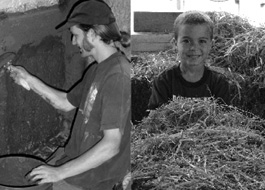
Sticky Situation: The Foster family held community workshops so friends and neighbors could help smear mud to protect their straw walls.
The First Straw
David Foster was the Santa Cruz ADU program's first loan recipient. He wanted to provide a home for his parents and, in the process, began an experiment in green building. The Fosters decided to build their ADU out of straw.
"My folks moved here in 1958 when I was 4 years old, and they bought a big old house with four bedrooms and two stories," recalls Foster, who's worked in the field of affordable housing for 25 years. "All the bedrooms and the bathrooms were upstairs, and they bought it for $12,000 dollars. That was when you could actually afford to live in Santa Cruz with any kind of job."
By the '90s, the Fosters started reaching the age where their house was too big for them, and David's mom couldn't get up and down the stairs anymore.
Foster says his parents actually began considering the possibility of an ADU for their property back in the 1980s. "They thought if they could build that, then they could move in the back, rent the front out and still stay in the same neighborhood that we'd all grown up in."
But at the time, policies were far more strict and limiting in terms of how, where, what size and who had a say in the construction of new ADUs.
"They found that if they built the unit, they'd have to have new additional parking spaces," he continues, "and those would have to be covered, so they'd have to build a garage as well as the granny unit. And they'd have to have all kinds of setback requirements, and they had to go through a public hearing process. And they knew the whole neighborhood would just come out in opposition to this. Nobody was building granny units, or Accessory Dwelling Units. It was a very, very difficult process."
Due to the high cost, the tangle of complicated building codes and an unwillingness to take on a battle with the neighbors, Ellie and Herb Foster abandoned the project, sold the house to their son and his family and moved into an apartment in downtown Santa Cruz.
"They kind of gave up that they could live in their same neighborhood. Then once we moved in here in the mid-'90s we started thinking, boy, wouldn't it be great if we could build a granny unit. We started looking into the codes and finding out how difficult it was and that nobody was doing it."
With the new ordinances, the Fosters are allowed to park in their driveway rather than having to build new parking spaces.
"But most importantly, we got rid of the public hearing requirement; granny units are [now] allowed by right." says Foster. "And that means if you own a single family lot, by right, without having to go through any hearings, you can build a single family home there, [and] you can also now build a granny unit on the same property. As long as you follow the rules and regulations of building it, you don't have to have a public hearing. And they can't say no to you as long as you're following within the regulations."
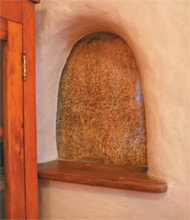
Photograph by Carlie Statsky
Truth Window: This small window is the only glimpse into the house's true contents.
Community Bale-in
In spite of the new regulations, Foster's challenges weren't over. Since building an ADU requires less time and money than a larger house, Foster decided to be as creative and ecologically conscious as his patience and wallet allowed. After researching a variety of possible green-building approaches, he chose a straw bale model. David was most attracted to the manner in which straw walls insulate but still allow air to circulate from one side of the wall to another. The list of promised benefits was incentive enough for the Fosters to take on an incredibly labor intensive and unique building process.
"When you build with straw bale, the roof goes on first," says Foster, pointing to a construction photo showing a wooden frame and a stack of rectangular bundles of straw that look more like a crude barn than the beginnings of a house. "And then what you're doing is in-filling, and building the straw bale walls up like that, and stacking them. It's a lot of labor because each straw bale has to be cut to be fit around a post, and to fit together in the corners."
The Fosters enlisted Boa Constructor Building and Design, a Watsonville-based company, as their general contractor. Boa's Michelle Landegger was the brains behind the straw, but the Fosters would need quite a few more hands to turn their pile of hay into a house.
"The most amazing part of building with straw is that it's a real community process," muses Foster. "A lot of this construction is regular, I mean you have a roofing crew come out, you have regular people coming out and doing things. But when it came to the straw bale walls, it became an incredible community process."
"So we had 45 people on a Saturday, and 30 people the next day. We had a huge long table and had everybody come, and we'd serve dinner for 40 in the driveway. And the amazing thing was that people came, really, from all over California. Because we advertised through this sort of network of straw bale builders, and people came from all over the place. They wanted to see how does it works and experience the process. So we had just an amazing crew of people coming and working on our house."
Again Foster points to a photo of the straw stacks and a group of people in work clothes. "This is my dad, my brother and Michelle Landegger. And then the landscaping part was done by my brother, [Ken Foster of] Terra Nova, you know, the bicycle-powered landscape company in town." [See story.]
Mudslinging Affirmations
Walking by the Foster's property, a passer-by might not give a second look to the granny unit out back, except to maybe notice the finely manicured landscaping or the textured-looking orange and brown finish of the outer walls. The secret ingredient of the house is completely concealed.
"Once you have the straw there, the problem with the straw bale is, you can't just cover it in paint and sheet-rock and whatnot and leave it alone. It has to be able to breathe. That's the whole concept, is that you're not only building 18-inch-thick walls that give you a beautiful feel and a lot of insulation, but you also have walls that breathe. And air actually will pass through the entire wall. And moisture will be picked up and will evaporate out of the wall over time and as humidity changes and things. So, in order to allow that to happen you have to have coverings that will protect the straw, but also that will allow it to breathe," Foster explains.
So with the help of about 30 people, the Fosters covered their straw house in mud.
"We had mud, and local dirt, and straw and sand, mixed together, and basically what you had to do is get a little ball of it and then throw it onto the wall and then smooth it in. It was so cool. Everybody was just covered in mud. So the mud was about an inch and a half thick," says Foster, laughing and motioning as if throwing a baseball.
"So we put down plastic and we threw mud around. That took a full weekend and a couple extra days for some of us, and once that was done it had to sit for about a month and dry. And as it slowly dries it would crack, all the corners would crack, everything would crack. So you had to mix up more of that and every week come back fill in those cracks and let it dry, and fill in cracks."
Even recalling all the hard work, interspersed with long periods of waiting, Foster retells the experience with a smile.
"And then one of the things we did in the closet was we had everybody in my family, and there's 13 of us that live in town now, we all put our handprints in the wall, so that we had all the family's fingerprints."
Foster explains that there's another reason their granny unit is so special. His parents are longtime peace activists and founding members of the Santa Cruz Friends [Quakers], so the ADU project became a place where the youth, the elderly and many friends convened.
"While we were stacking the straw, we had a table where people could come and write little wishes for my folks, or greetings, or little prayers, or little poems or whatever they wanted to write on little pieces of paper. And then we shoved those pieces of paper in the walls between the straw bales, so that their walls are completely filled with nice thoughts for them. It definitely gave more of a community feel to this thing."
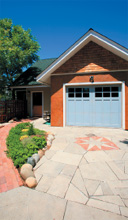
Photograph by Carlie Statsky
A Family Affair: David Foster's brother Ken and his Terra Nova Ecological Landscaping Company were responsible for the new unit's yard.
Granny Fraud?
Although the increase in the number of Santa Cruz ADUs has led to some neighborhood complaints, such issues can often be addressed through good neighbor communication and a little old-fashioned politeness.
"Now that we're getting to have an older population and we also have a population with a lot more single people, we don't have a housing stock that's set up to handle the population that we now have," says Foster. "If we were all married and had two-point-five kids, then probably our housing stock would be perfect for us. But if we have students and older people and single people who are living alone--we don't have anything that works for them. One idea of the granny unit is simply to build more diversity in our housing stock."
Diversity, however, is not what all Santa Cruz home owners feel they bargained for when moving in to quiet low-density neighborhoods. The process of changing ADU policies in Santa Cruz was at times a hairy endeavour, due to many home owners holding on to the American dream, and to their ocean view.
Aldo Giacchino, executive committee chair of the Sierra Club Santa Cruz County Group, still holds concerns about second-story units (such as those built above garages) blocking neighbors' sunlight and diminishing privacy. He also takes issue with who some of the units are being rented to.
"By the way, 'grannies' is a total fraud," says Giacchino. 'There are no grannies living in these places. These are second rental units. And they're all rented to students, principally. There isn't a single granny who lives in these units."
According to Giacchino, "ADUs are just a way to expand the growth of the student population. I think they should be housed on campus. Not to say that there shouldn't be any students living in town, but the university housing is grossly inadequate.
Because ADUs are built on private property, it's impossible to track which people are their predominant residents.
But Foster and Primack both believe that students living in town wouldn't be as big of a problem if more ADUs were available to house them, rather than the large, family-style homes rented out to groups of students that tend to become notorious "party houses."
Barney Elders, an attorney who's practiced law in Santa Cruz for over 30 years, filed a lawsuit against the city four years ago in regard to ADUs on behalf of his neighbors, citing impacted parking as a major complaint.
Lynn Robinson, one of the founding members of the Santa Cruz Neighbors, believes that many issues created by ADUs can be remedied by increased communication between neighbors, and by increased education of the public as to what ADUs are and the changes that they can bring to neighborhoods, both positive and negative.
"When it comes to ADUs, you're adding more, not less, to a neighborhood," says Robinson, "and you have to do that carefully."
For proponents, ADUs are ultimately a way to give some agency back to the general public. "That was really the idea of granny units, was to do something small enough scale, something that doesn't have the huge expanse of land tied to it," says Foster. "Really anybody that owns land--that owns a single-family home with a minimum lot size--is going to be able to qualify and build something."
Send a letter to the editor about this story.
|
|
|
|
|
|